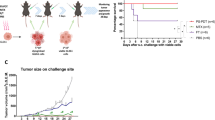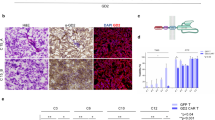Abstract
Enhanced immunogenicity has been reported following transfection of a variety of immunogenic tumors with the B7.1 co-stimulatory molecule. The purpose of the present study was to determine if transfection of a weakly immunogenic rat brain tumor, the F98 glioma, with the gene encoding B7.1 could enhance its immunogenicity. F98 cells were transfected with a plasmid containing the B7.1 gene, and stable transfectants (F98/B7.1) were obtained. Flow cytometric analysis confirmed the expression of B7.1 and MHC class I antigens on the cell surface. To investigate the effects of B7.1 expression on the tumorigenicity of the F98 glioma, Fischer rats were implanted intracerebrally with either F98 (wild-type) or F98/B7.1 transfected cells. No significant differences in survival times were noted. Mean survival times of 21.8 and 24.0 days were observed for the respective groups at a challenge dose of 103 cells. These differences in survival time were not significant. To determine if expression of B7.1 enhanced the immunogenicity of the F98 glioma, rats were vaccinated weekly for 3 weeks with 107 mitomycin C-treated F98 or F98/B7.1 cells injected subcutaneously and then challenged intracerebrally with F98 cells 1 week later. Unvaccinated animals or those that received wild-type F98 cells as a vaccine had a survival time (mean ± s.d.) of 22.3 ± 1.5 days following tumor challenge versus 20.0 ± 1.7 days for rats that had been vaccinated with F98/B7.1. Although we recognize that it might be possible to design more effective vaccination regimes, nevertheless, our data indicate that transfection of the B7.1 gene into the F98 rat glioma did not enhance its immunogenicity, and that other approaches will be required.
This is a preview of subscription content, access via your institution
Access options
Subscribe to this journal
Receive 12 print issues and online access
$259.00 per year
only $21.58 per issue
Buy this article
- Purchase on Springer Link
- Instant access to full article PDF
Prices may be subject to local taxes which are calculated during checkout





Similar content being viewed by others
References
Schultze J, Nadler LM, Gribben JG . B7-mediated costimulation and the immune response Blood Rev 1996 10: 111–127
Schwartz RH . Costimulation of T lymphocytes: the role of CD28, CTLA-4, and B7/BB1 in interleukin-2 production and immunotherapy Cell 1992 71: 1065–1068
Chambers CA et al. The role of CTLA-4 in the regulation and initiation of T-cell responses Immunol Rev 1996 153: 27–46
Chen L et al. Costimulation of antitumor immunity by the B7 counterreceptor for the T lymphocyte molecules CD28 and CTLA-4 Cell 1992 71: 1093–1102
Chen L et al. B7-1/CD80-transduced tumor cells elicit better systemic immunity than wild-type tumor cells admixed with Corynebacterium parvum Cancer Res 1994 54: 5420–5423
Townsend SE, Allison JP . Tumor rejection after direct costimulation of CD8+ T cells by B7-transfected melanoma cells Science 1993 259: 368–370
Zheng P, Liu Y . Co-stimulatory molecules B7-1 and B7-2 as experimental therapeutic targets Emerg Ther Targets 1999 3: 93–108
Baskar S et al. Constitutive expression of B7 restores immunogenicity of tumor cells expressing truncated major histocompatibility complex class II molecules Proc Natl Acad Sci USA 1993 90: 5687–5690
Ramarathinam L, Castle M, Wu Y, Liu Y . T cell costimulation by B7/BB1 induces CD8 T cell-dependent tumor rejection: an important role of B7/BB1 in the induction, recruitment, and effector function of antitumor T cells J Exp Med 1994 179: 1205–1214
Zheng P et al. B7-CTLA4 interaction enhances both production of antitumor cytotoxic T lymphocytes and resistance to tumor challenge Proc Natl Acad Sci USA 1998 95: 6284–6289
La Motte RN, Sharpe AH, Bluestone JA, Mokyr MB . Host B7-1 and B7-2 costimulatory molecules contribute to the eradication of B7-1-transfected P815 tumor cells via a CD8+ T cell-dependent mechanism J Immunol 1999 162: 4817–4823
Davis FG et al. Survival rates in patients with primary malignant brain tumors stratified by patient age and tumor histological type: an analysis based on surveillance, epidemiology, and end results (SEER) data, 1973–1991 J Neurosurg 1998 88: 1–10
Shapiro WR . Current therapy for brain tumors Arch Neurol 1999 56: 429–432
Tapscott SJ et al. Gene therapy of rat 9L gliosarcoma tumors by transduction with selectable genes does not require drug selection Proc Natl Acad Sci USA 1994 91: 8185–8189
Barba D, Hardin J, Sadelain M, Gage FH . Development of anti-tumor immunity following thymidine kinase-mediated killing of experimental brain tumors Adv Tech Stand Neurosurg 1994 91: 4348–4352
Kaneko S, Allen NJ, Clendenon NR, Kartha M . Treatment schedule of combination using radiation and ACNU in the experimental brain tumors Neurol Medico-Chir 1983 23: 849–855
Tzeng JJ, Barth RF, Orosz CG, James SM . Phenotype and functional activity of tumor-infiltrating lymphocytes isolated from immunogenic and nonimmunogenic rat brain tumors Cancer Res 1991 51: 2373–2378
Tzeng JJ, Barth RF, Orosz CG . Quantitation of glioma-reactive cytolytic T lymphocyte precursors by means of limiting dilution analysis J Immunol Meth 1992 146: 177–184
Barth RF et al. Boron neutron capture therapy of brain tumors: enhanced survival following intracarotid injection of either sodium borocaptate or boronophenylalanine with or without blood–brain barrier disruption Cancer Res 1997 57: 1129–1136
Barth RF et al. Rat brain tumor models in experimental neuro-oncology: the 9L, C6, T9, F98, RG2 (D74), RT-2 and CNS-1 gliomas J NeuroOncol 1998 36: 91–102
Blume MR, Wilson CB, Vazquez DA . Immune response to a transplantable intracerebral glioma in rats. In: Sane K, Ishi S, LeVay D (eds) Recent Progress in Neurologic Surgery Excerpta Medica: Amsterdam 1974 129–134
Denlinger RH, Axler DA, Koestner A, Liss L . Tumor-specific transplantation immunity to intracerebral challenge with cells from a methylnitrosourea-induced brain tumor J Med 1975 6: 249–259
Holladay FP et al. Successful treatment of a malignant rat glioma with cytotoxic T lymphocytes Neurosurgery 1992 31: 528–533
Holladay FP, Heitz T, Wood GW . Antitumor activity against established intracerebral gliomas exhibited by cytotoxic T lymphocytes, but not by lymphokine-activated killer cells J Neurosurg 1992 77: 757–762
Holladay FP, Choudhuri R, Heitz T, Wood GW . Generation of cytotoxic immune responses during the progression of a ratglioma J Neurosurg 1994 80: 90–96
Sawamura Y, de Tribolet N . Immunobiology of brain tumors Adv Tech Stand Neurosurg 1990 17: 3–64
Wu TC et al. A reassessment of the role of B7-1 expression in tumor rejection J Exp Med 1995 182: 1415–1421
Judge TA et al. Cloning the rat homolog of the CD28/CTLA-4-ligand B7-1: structural and functional analysis Int Immunol 1995 7: 171–178
Peach RJ et al. Both extracellular immunoglobin-like domains of CD80 contain residues critical for binding T cell surface receptors CTLA-4 and CD28 J Biol Chem 1995 270: 21181–21187
Guo Y et al. Mutational analysis and an alternatively spliced product of B7 defines its CD28/CTLA4-binding site on immunoglobulin C-like domain J Exp Med 1995 181: 1345–1355
Onodera K et al. CD28-B7 T cell costimulatory blockade by CTLA4Ig in sensitized rat recipients: induction of transplantation tolerance in association with depressed cell-mediated and humoral immune responses J Immunol 1997 159: 1711–1717
Visse E, Siesjö P, Widegren B, Sjögren HO . Regression of intracerebral rat glioma isografts by therapeutic subcutaneous immunization with interferon-gamma, interleukin-7, or B7-1-transfected tumor cells Cancer Gene Ther 1999 6: 37–44
Siesjö P et al. Immunization with mutagen-treated (tum-) cells causes rejection of nonimmunogenic rat glioma isografts Cancer Immunol Immunother 1993 37: 67–74
Chong H, Hutchinson G, Hart IR, Vile RG . Expression of co-stimulatory molecules by tumor cells decreases tumorigenicity but may also reduce systemic antitumor immunity Hum Gene Ther 1996 7: 1771–1779
Chen L et al. Tumor immunogenicity determines the effect of B7 costimulation on T cell-mediated tumor immunity J Exp Med 1994 179: 523–532
Souberbielle BE et al. Comparison of four strategies for tumour vaccination in the B16-F10 melanoma model Gene Therapy 1998 5: 1447–1454
Tully M . Preparation of bacterial plasmid DNA Meth Mol Biol 1995 46: 213–223
Slatko BE . Thermal cycle dideoxy DNA sequencing Mol Biotechnol 1996 6: 311–322
Swenberg JA, Koestner A, Wechsler W . The induction of tumors of the nervous system with intravenous methylnitrosourea Lab Invest 1972 26: 74–85
Ko L, Koestner A, Wechsler W . Morphological characterization of nitrosourea-induced glioma cell lines and clones Acta Neuropathol 1980 51: 23–31
Ko L, Koestner A, Wechsler W . Characterization of cell cycle and biological parameters of transplantable glioma cell lines and clones Acta Neuropathol 1980 51: 107–111
Acknowledgements
David B Paul was supported by the National Cancer Institute, National Research Service Award CA-09338, Division of Cancer Prevention and Control and the research was supported by a Board of Regents Targeted Interdisciplinary Seed Grant, Office of Research, The Ohio State University and The Ohio State University Comprehensive Cancer Center.
Author information
Authors and Affiliations
Rights and permissions
About this article
Cite this article
Paul, D., Barth, R., Yang, W. et al. B7.1 expression by the weakly immunogenic F98 rat glioma does not enhance immunogenicity. Gene Ther 7, 993–999 (2000). https://doi.org/10.1038/sj.gt.3301209
Received:
Accepted:
Published:
Issue Date:
DOI: https://doi.org/10.1038/sj.gt.3301209
Keywords
This article is cited by
-
Rat brain tumor models in experimental neuro-oncology: the C6, 9L, T9, RG2, F98, BT4C, RT-2 and CNS-1 gliomas
Journal of Neuro-Oncology (2009)
-
Stable expression of chimeric anti-CD3 receptors on mammalian cells for stimulation of antitumor immunity
Cancer Gene Therapy (2003)



